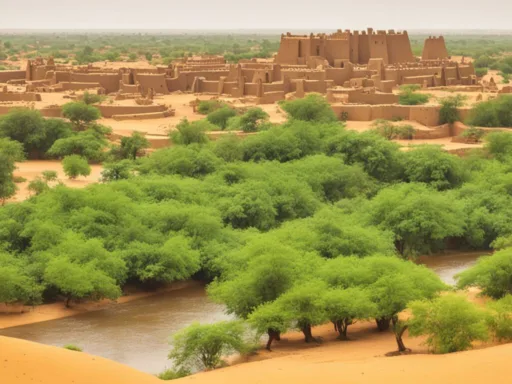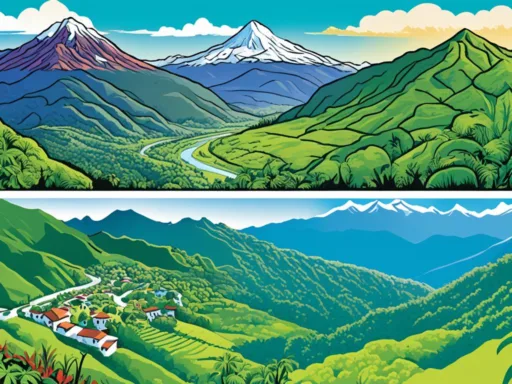Often, the tiny West African nation of Benin doesn’t make it to the top of travel bucket lists, yet those who overlook this diamond in the rough miss out on a transcendental cultural sojourn. Grappling with the question, what is the best time to visit Benin, compels one to consider not just climatic conditions, but cultural rhythms and local festivities to truly experience the heartbeat of this vibrant country. With a rich tapestry of traditions and natural splendor, understanding the Benin Tourism Calendar and the nuances of the Benin Weather Guide serves as your compass to navigating an authentic journey through the historic kingdom of Dahomey.
Whether you’re drawn to the Royal Palaces of Abomey or the serene beaches that grace the coastline, timing your visit optimally can transform a simple sightseeing trip into an expedition filled with deep cultural engagement and eye-opening historical revelations. Let us guide you through the seasonal variations and festivities that illuminate Benin’s calendar, so you can plan your travel with confidence and intrigue.
Key Takeaways
- Identify the ideal travel months within the Benin Tourism Calendar for outdoor activities and cultural festivals.
- Gain insights into how the Benin Weather Guide influences the ebbs and flows of travel experiences throughout the year.
- Learn about the significance of the dry season and its impact on your ability to explore Benin’s majestic sites and vibrant culture.
- Discover the array of cultural events that take place during various seasons, offering a richer, more immersive experience.
- Unveil the crossroads of climate and culture to determine the best time to visit Benin for your ultimate adventure.
Embarking on a Journey to Benin: A Prelude to Vibrant Discoveries
Discovering Benin offers an immersive experience into a world brimming with cultural riches and historical depth. From the colorful markets teeming with daily life to the serene stretches of golden beaches, your visit will be brightened by the warm welcome of the Beninese people. Embracing the Ideal Months in Benin for travel can significantly enhance your journey, aligning with festive cultural events and pleasant climatic conditions.
Preparations for your trip should include practical Benin Travel Tips to navigate the country’s nuances. Acknowledge that despite Cotonou’s bustle, Porto-Novo is the seat of government and the country’s official capital. As you handle transactions, remember that the local currency is the XOF — Communaute Financiere Africaine franc, and that electronic devices should be compatible with a 220V electrical system. U.S. travelers will find ease in preparations with streamlined visa and passport services provided by platforms like iVisa.
Engage fully with Benin by timing your visit to coincide with key celebrations that showcase the nation’s vibrant heritage. The vivacity of Traditional Religions Day, the unity observed on Labor Day, and the patriotic fervor of Independence Day serve as windows into the heart of Beninese culture.
- Plan your visit between November and February, aligning with the dry season for optimal exploration.
- Participate in vibrant local festivals to enrich your cultural insight.
- Engage with locals to delve deeper into the traditions and everyday life in Benin.
Let each step of your journey be guided by a spirit of discovery, immersing yourself in the diverse narratives that weave the fabric of this enchanting nation. Safe travels, and may the beauty of Benin leave a lasting impression on your heart and memories.
Best Time to Visit Benin
For discerning travelers planning their itineraries, pinpointing the top seasons in Benin becomes crucial to maximize the journey’s potential. Heeding the question of when to go to Benin, the dry season emerges as a prime candidate, offering a combination of comfortable weather and accessible outdoor adventures. Let us delve into what makes these months an optimal time for a visit.
Embracing the Dry Season: November to March
The balmy days stretching from November to March lay down the red carpet for explorers seeking the warmth of sunlit days. Benin’s prized attractions, from remarkable wildlife parks to the relics of ancient kingdoms, stand in full glory under the dry season’s clear azure skies. This period is ideally suited for those wishing to explore without the hindrance of rain, ensuring a journey rich with uninterrupted discovery.

Navigating the Harmattan Winds
While the dry season boasts numerous travel perks, one remarkable natural phenomenon, the Harmattan winds, sweeps across the Sahel region into northern Benin. This dusty breeze may at times obscure the skies and chill the air, but also imparts the landscape with a serene, otherworldly beauty. Adventurers keen to experience Benin’s full natural spectrum relish this seasonal quirk, despite the occasional drop in visibility it brings.
Seasonal Celebrations and Cultural Events
Benin’s cultural heartbeat resonates through its numerous festivities that pepper the calendar year. While the rainy season from June to September might challenge travelers with its downpours, it compensates with flourishing greenery and vibrant cultural expressions. Celebrations during this time reflect the rich tapestry of Benin’s traditions, making it a period ripe for cultural immersion and festivity.
| Season | Travel Experience | Cultural Events |
|---|---|---|
| Dry (Nov – Mar) | Clear skies, ideal for outdoor explorations and historical site visits | Limited due to less rainfall; mostly national holidays and new year celebrations |
| Rainy (Jun – Sep) | Lush landscapes, occasional travel interruptions due to heavy rains | Abundant, including traditional festivals and religious ceremonies |
Exploring the Cultural Tapestry and Historical Landmarks of Benin
The cultural landscape of Benin unfolds as a vibrant mosaic of traditions and history. As a guide for those embarking on a Benin travel journey, it’s essential to delve into the spiritual identity of the nation, prominently marked by Vodou—an indigenous religion often shrouded in mystery, yet central to the Beninese way of life. The religion’s mystical narratives and ceremonies offer a unique experience for travelers looking to engage deeply with the local culture.
Beyond the spiritual, Benin’s environmental diversities are a haven for wildlife enthusiasts. From the impressive birdlife to the encounters with megafauna, the country’s premier reserves provide a backdrop for unforgettable natural experiences. This rich tapestry is not only woven with nature and spirituality but also with the threads of history. The echoes of the slave trade resonate through historical sites and coastal forts, serving as poignant reminders of a bygone era.
Moreover, the historied essence of Benin is complemented by its physical allure—palm-fringed golden beaches provide a relaxing counterpoint to the bustling city markets. With a seasoned blend of varied and spicy cuisine, Benin extends its hospitality, inviting visitors to savor its culinary delights alongside its friendly and exuberantly dressed populace. Indeed, a Benin cultural journey is painted with the broad strokes of immersive history, rich flavors, and living tradition. Here’s a glimpse of what to expect:
| Cultural Highlights | Historical Landmarks | Natural Attractions |
|---|---|---|
| Vodou ceremonies | Royal Palaces of Abomey | Pendjari National Park |
| Marketplaces in Cotonou | Ouidah Slave Route | Lake Ahémé and Ganvié |
| Festivals & Traditional Celebrations | The Fort of São João Baptista de Ajudá | Coconut Palm-fringed beaches |
In every step along your Benin cultural journey, you’ll find a country exuberant with life, eager to share its story. Whether through the spiritual vibrancy of its people, the haunting beauty of its historical memories, or the unforgettable encounters with nature’s bestowment—Benin leaves an immeasurable imprint on the hearts of those who traverse its land.
Benin’s Breathtaking Landscapes: Where Nature’s Beauty Prevails
Embarking on an adventure through the vibrant nation of Benin, one cannot help but be captivated by the majesty of its natural endowments. As we delve into this section of our Benin travel guide, we immerse ourselves in the spectacular scenes that define this West African gem. The allure of Benin’s environment is not just in the diversity it boasts but also in the harmonious balance it maintains between burgeoning wildlife and serene coastal havens, pivotal elements of any Benin Tourism Calendar.
Pendjari National Park: A Wildlife Sanctuary
Nestled in the northwestern reaches of Benin, the Pendjari National Park stands as a testament to the untamed beauty African landscapes have to offer. Recognized as a key conservation area for a myriad of rare and endangered species, it invites travellers from around the globe to partake in wildlife viewings that are as authentic as they are intimate. This park is a hub of biodiversity, showcasing nature untouched by modern excess, where animals like elephants, lions, and hippos roam freely, enchanting all who visit.
Coastal Escapes: Sun, Sand, and Serenity
Complementing the dynamic wildlife experiences inland, Benin’s coasts tell their own tranquil tale. Here, untouched beaches delineated by whispering palm trees offer a retreat for those in pursuit of calm and a harmonious blend of sun, sand, and sea. These serene stretches of coastline embody a purity that rejuvenates the spirit, highlighting the understated yet profound beauty that the country holds. Whether it’s a lazy afternoon basking in the golden sunlight or a reflective stroll along the shoreline, the coastal areas of Benin are sanctuaries of natural serenity, integral to any traveler’s itinerary.
FAQ
What are the best months to visit Benin for a rich cultural experience?
The optimal months for a cultural visit to Benin are during the dry season from November to March when the weather is favorable for attending vibrant festivals and exploring historical sites.
What should I know before embarking on a journey to Benin?
Prior to your trip to Benin, familiarize yourself with the official capital Porto-Novo, the currency XOF, the 220V electric system, and visa requirements which can be managed through services like iVisa.
Why is the dry season from November to March considered the best time to visit Benin?
This period offers hot and dry weather ideal for outdoor activities and sightseeing. However, be aware that the Harmattan winds can reduce visibility, especially in the north.
How do the Harmattan winds affect travel in Benin?
The Harmattan winds, usually between December and February, can bring dust and lower visibility. While they may create unique atmospheric conditions, they can also disrupt air travel and reduce air quality.
What are some seasonal celebrations and cultural events I can experience in Benin?
Travelers can immerse themselves in events like Traditional Religions Day, Labor Day, and Independence Day that showcase the country’s diverse cultural fabric and traditions.
Can you describe the cultural journey one can experience in Benin?
Visitors to Benin can expect to discover a cultural tapestry woven from Vodun practices, Christian and Islamic influences, and a poignant historical legacy marked by the African slave trade and colonial history.
What makes Pendjari National Park a must-visit destination in Benin?
Pendjari National Park is regarded as one of the finest wildlife sanctuaries in West Africa, home to rare and endangered species, offering authentic wildlife viewing experiences.
Where can I find serene beaches in Benin?
Benin boasts unspoiled beaches along its coast, ideal for relaxation and nature enjoyment. The beaches provide a serene environment for visitors looking to bask in the harmony of sun, sand, and sea.






